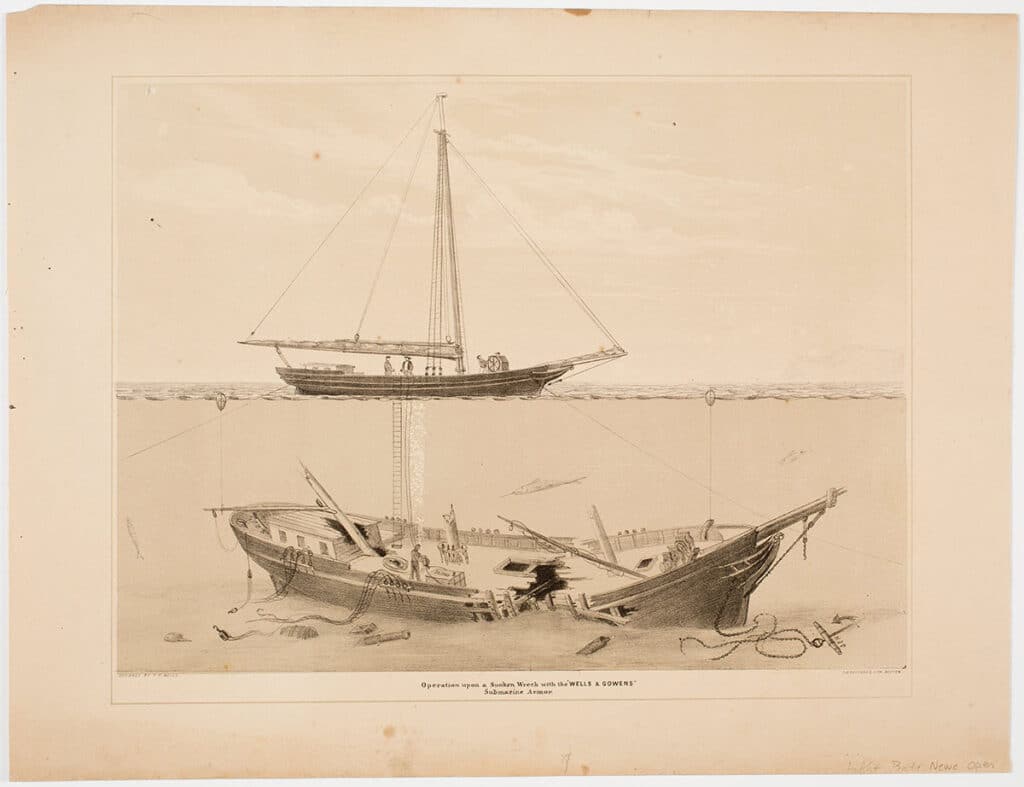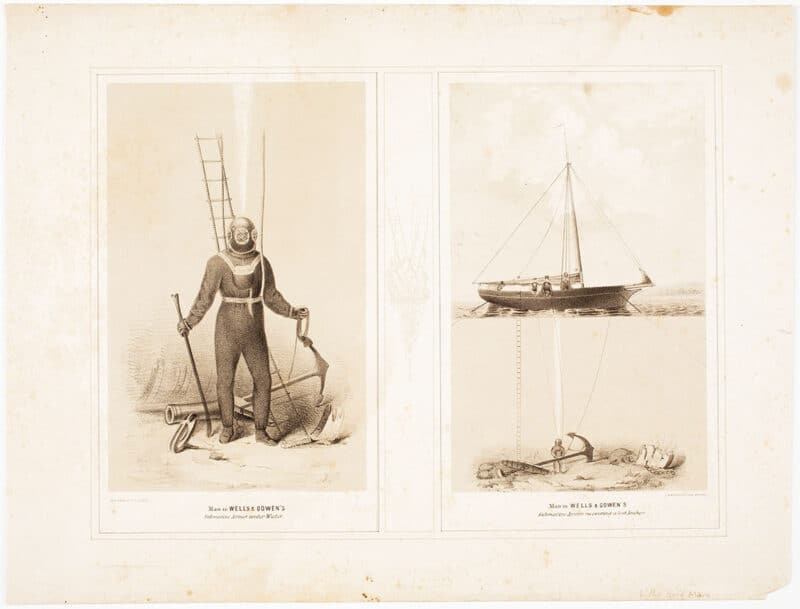by James Grieder
I’ve been working at the Nantucket Atheneum as a research associate for a little over a year, and in that time, I’ve fallen down more than one historical rabbit hole, learning about interesting and some downright odd moments in Nantucket’s history. From time to time, my explorations bring me face-to-face with members of my own family.
One of my on-going projects is to compile a list of all the speakers and other entertainers who have appeared on stage at the Atheneum from its very beginning, a period spanning nearly two centuries. Reading the digitized copies of Nantucket newspapers in the Atheneum’s collection, with a focus on one of the island’s main cultural institutions, I’ve witnessed the prosperity and optimism of Nantucket at the height of its whaling industry, followed by mounting concern as more and more business flowed to the upstart New Bedford port rather than Nantucket. The crews of whalers literally abandoned ship and ran off into the hills to press their luck there during the Gold Rush, leaving no one to continue whaling, or even to return the vessel to its home port. Advancements in lighting technology, and the sinking of the first oil well in Pennsylvania, meant that whale oil and its by-products like spermaceti candles weren’t as sought-after as they had been. Investments dried up during the Panic of 1857, when over-extended businessmen were ruined, and the island’s economy cratered.
The newspapers are full of articles touting the latest industry that Nantucketers were trying to import—manufactories for silk, hats, shoes, new crops to grow, new animals to breed. A lot of people were out of work, and island leaders were desperate to restart the economy. An article in the August 11, 1860 edition of the Nantucket Weekly Mirror that caught my eye was about a submarine experiment involving a “suit of armor” that had been purchased by a local company, to be used in salvage operations on the many shipwrecks in Nantucket waters.
The device was demonstrated by a Mr. Perry, working from the Silas Parker, a vessel moored between Straight and Old South wharves. He climbed down a ladder wearing the “suit of armor” and descended about twelve feet down to the bottom of the harbor. Perry walked around for nearly ten minutes, with air bubbles on the surface marking his passage. He then climbed back up the ladder to say that the silt from walking had muddied the water, making it impossible for him to see, but he’d go back down if the owners wanted him to. The owners were satisfied with the results, and soon the suit was used to raise several tons of coal from the Sarah Woodbridge, wrecked on Long Shoal the previous spring. The article concludes by noting that Captain D.G. Patterson was given charge of the device, and that Perry, “who has been employed in getting up the sunken ships at Sebastopol,” would remain on-island to answer questions about the apparatus.
I’d heard of diving bells and similar devices being used for underwater operations in the 18th century, but had always understood atmospheric diving suits to be a much later development. I returned to the article for clues. There’s a plethora of Perrys online, but none that I could identify with certainty; nor was there a trace of the ship Silas Parker. D.G. Patterson was an erstwhile whaling captain from Nantucket, trying his hand at a new enterprise. It was the phrase “sunken ships at Sebastopol” that brought a trove of information to light.
In the mid-1850s, the Crimean War was initially being waged between the Russian and Ottoman empires. When it appeared that the Ottomans were faltering, a coalition of European nations, including France and Great Britain, entered the conflict to prevent Russia from becoming dominant in the region. British and French fleets entered the Black Sea in January 1854, and later that year allied forces landed near Sevastopol, home to Russia’s southern fleet, and began a siege of the city that lasted eleven months.

When it became apparent an attack was immanent, the Russian defenders blocked the entrance to the harbor by sinking older sailing ships at the mouth of the bay. One year later, as the Czar’s forces abandoned the town, the remainder of the Black Sea Fleet, along with transports and merchant vessels, was also scuttled. Nearly a hundred ships carpeted the bottom of the bay when British, French, and Turkish forces occupied the port. English engineers pronounced the job of raising the hulks an impossibility, and were content to let them rot–a slow process that would ensure the strategic port remained unusable for years to come.
The Yankee Expedition to Sebastopol by Chuck Veit, tells the story of the Russians’ solution once they’d regained control of the city: one that involved a young American from Lynn, MA named John E. Gowen, who’d developed a reputation for salvaging ships that experts had deemed unsalvageable. The rewards were considerable—the value of sunken ships was estimated to be roughly $65 million (an eye-watering $2.313 billion today), along with some $800,000 worth of chains and anchors that the English and French had thrown overboard after the siege. What’s more, on the warships the mechanical equipment had been covered with a preparation of tallow to prevent water damage: hopes were high that many were in decent condition and could be salvaged.
The plan was to use a diving bell and submarine armor to explore the vessels and prepare them to be raised by sealing any holes and pumping the water out of the hulk. Then sacks made airtight with tar or gutta percha—an early stand in for rubber— were to be fastened to the sides of the ships and inflated with air to bring them to the surface. Marine camels, similar to the ones depicted in the model on display in the Nantucket Whaling Museum, along with steam engines and hydraulic pumps, were sent to Sevastopol to assist with the salvage.
Problems plagued the project from the start. Gowen’s crew wasn’t making much progress, in large part due to the fact that they were essentially learning by trial and error. The condition of the ships was also much worse than expected— those sunk to block the harbor entrance were older vessels at the end of their lifespan even before they slipped beneath the waves, and many of the wrecks had become deeply embedded in mud and sand. The carefully scuttled modern steamships had largely fallen prey to the teredo worm of the Black Sea, and the timber was so rotten that the water ran through it like a sieve.
The Russians grew impatient at the delay, and a rival salvage operation, the Boston Relief and Submarine Company, was brought in to help. The new company was on a steep learning curve to match Gowen’s by now well-skilled crew, and a letter to the Philadelphia Press in August 1857 depicts the Bostonians as rank amateurs:
“ ‘An old practical diver,’ as he represented himself to be, from Boston, was the first to begin operations, but he made such a bungling attempt that an Englishman, who had been in the employment of the Russians as diver for eight months previous, and was engaged by our company, insisted that this must have been the very first time the Bostonian had ever been in the water. ”
In the end, the Boston company pulled out of the project, citing financial reasons. The anchors and cables raised were sufficient to cover some of the expenses of the companies, but not all of them, and the condition of the wrecks meant there wouldn’t be much salvage to split between the two companies. There was confusion in the American press at first, with claims that both companies had ceased operations, but it became clear that the “Philadelphia company” was still on the job. The Boston crew is no longer mentioned in the archive, and must have returned to the USA. It’s plausible that Perry or someone else associated with Boston Relief and Submarine Company convinced an out-of-work whaling captain on Nantucket to invest in a new salvage venture in island waters. That’s only speculation, but how many submarine suits of armor could there have been floating around New England in those days?
Made of rubberized cloth sandwiched between layers of canvas, the “suit of armor” was more suit than armor. The helmet was that iconic brass or copper globe with small glass-covered “portholes” for seeing out of that we’ve all seen in old movies and restaurant fish tanks. The air supply came from a tube tucked under the arm that connected to the helmet: if anything went wrong, there was a rope to tug on. The whole suit weighed more than 100 pounds, largely due to the lead weights used to keep the diver submerged.
Meanwhile, topside, a crew of three worked together to keep the diver alive: one monitoring the air hose to keep it unobstructed, one manning pumps supplying the air, and one keeping an eye on the signal rope.
Operators complained that the outfits leaked badly, and sometimes there was “no less than two or three buckets of water in it.” There was no insulation to the suits beyond the layers, so they would have gotten very cold very quickly. Meanwhile, the air that came through the breathing tube was scorching hot from being pumped through the machinery. And shuffling about the bottom in lead-lined boots inevitably stirred up a cloud of silt, reducing visibility to zero. It’s amazing they were able to salvage anything at all, under those conditions.
But they did, including tons of coal from the wrecked Sarah Woodbridge. Long Shoal, where they salvaged the coal from that schooner, lies between and to the north of Muskeget and Chappaquiddick Island. Today inter-island ferries pass just north of the hazard, and it’s easy to see how a ship could wreck there. It’s impressive that a diver could succeed in a region of surging tides.
But how did the ship come to be wrecked on Long Shoal to begin with, and what happened to her crew? When I googled the vessel’s name, Sarah Woodbridge, I stumbled across an unexpected family connection: the first result that popped up was a link to an article about my grandmother, Ruth Chapel Grieder. She was being recognized for her work with the Nantucket Shipwreck and Lifesaving Museum, and told the story of the rescue of the crew of the Sarah Woodbridge by James C. Dunham of Tuckernuck, her great-grandfather.
It wasn’t long after the doomed schooner struck the shoal during a severe storm on Christmas Day that Tuckernuckers spotted the distressed vessel. A crew of local men under the command of Dunham made their way out to the wrecked ship in a Humane Society lifeboat. With the high seas and a roaring gale it was impossible to get all to shore safely. Dunham instructed the Tuckernuck crew to head back to the island and wait for his signal before attempting a second rescue. That night, the Sarah Woodbridge filled with water: all hands were forced to the quarterdeck, which was a mass of ice. They implored Dunham to signal for another rescue attempt, but he knew it would not be successful with the current conditions. Wet, miserable, and on the edge of hypothermia, Dunham fashioned the main sail into a shelter and hunkered down for the rest of the night. At dawn, the steamer Island Home approached the desperate men but was unable to get close enough to render assistance.
When the weather eased slightly, Dunham signaled to the men on Tuckernuck, and the lifesaving crew responded quickly. All hands were safely brought to Muskeget. Dunham was a local hero after his night aboard the wrecked Sarah Woodbridge, though he never received official recognition for his remarkable rescue. What’s more, if I’d ever heard that story growing up, I’d forgotten all about it because it was news to me: stories about James C. Dunham that remembered were about him being the black sheep of Tuckernuck who waged—and lost—a war of inconvenience on Boston Brahmins who came to the island to swim in the nude and lounge about in kimonos. But that is a story for another time.



